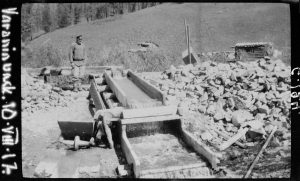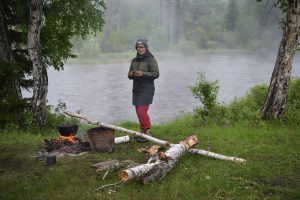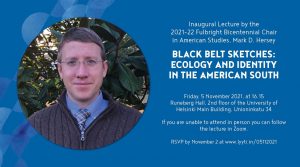Hunting for Hope: New Perspectives on the History of Game and Fish Management Online Workshop
For ZOOM Link please register HERE by Nov 8. You will receive the ZOOM link an hour before the event.
Historians have devoted a great deal of attention to the history of hunting and fishing. Yet, as this session shows, many of the assumptions that have driven those histories merit investigation. This session thus unites five papers that reframe the history of game and fish management in new ways, despite offering divergent approaches to the subject. In the first paper, Erki Tammiksaar draws on the rich fishery survey data of Lake Peipsi, stretching from Karl Ernst von Baer’s famed 1851-1852 expedition to the present day, to assess changes in the lake’s fish population over time, connecting those shifts to a number of factors, including climate change. Victoria Peemot centers her attention on the 1917 Finnish Geological Expedition to Uriankhai, approaching it as a multispecies venture in which the human participants paid a great deal of attention to game.In her paper, Anastasia Fedotova explores the reasons for the preservation of European red deer during the long nineteenth century in regions where the kind of intensive agriculture that would typically explain its extinction were still practiced. Drew Swanson takes a different approach in his study of white-tailed deer in the United States, turning his focus to the cultural construction of hunting regulations. In his case, American hunters internalized early efforts to protect does to the degree that many came to see bucks as the only ethical game—an attitude that proved difficult to undo and that contributed to mid-twentieth century population irruptions. Mark Hersey also looks at the unanticipated consequences of wildlife management in the US, underscoring the ways in which efforts to preserve wildlife took a distinctive regional form, one that problematizes assessments of success and failure.
—
Panelists
Anastasia Fedotova, Institute for the History of Science and Technology, Russian Academy of Science; Collegium for Advanced Studies, Helsinki University
Mark D. Hersey, Mississippi State University, Fulbright Bicentennial Chair in American Studies, University of Helsinki
Victoria Soyan Peemot, University of Helsinki
Drew Swanson, Wright State University
Erki Tammiksaar, Estonian University of Life Sciences, Centre for Science Studies
Chair: Mikko Saikku, University of Helsinki
—
Presentations:
Erki Tammiksaar, Estonian University of Life Sciences, Centre for Science
Fish and fishing in Lake Peipsi (Estonia/Russia) since 1851: similarities and differences between historical and modern times
The first survey data on the fisheries in Lake Peipsi were collected by Baltic German natural scientist Karl Ernst von Baer as a result of the world’s first special fishery expedition in 1851–1852. In the current presentation, all available numerical datasets on fishing in Lake Peipsi from 1851 to 2018 have been drawn together in order to analyse the long-term changes in the lake’s fish assemblages. As the study indicates, the overexploitation, catching of juvenile fish and predator–prey imbalance have been common problems associated with fisheries in Lake Peipsi for the last two centuries. Similar to many inland waterbodies worldwide, total catch of fish from Lake Peipsi has decreased about four times since the mid-19th century, and the decline of cool-water fish, such as vendace, burbot and Peipsi whitefish during the last two centuries, and the domination of warm-water fish, such as Eurasian perch, common bream and pike-perch in the catches of the last 20 years mark considerable structural shifts in fish assemblages. Of the multiple stressors (e.g., nutrient enrichment, increased water temperature, overfishing) triggering shifts in fish assemblages, the impact of climate warming, especially extreme weather events such as heatwaves, seems to be the strongest during the last three decades.
—
Victoria Soyan Peemot, University of Helsinki
A Geological Expedition As The Multispecies Venture
This study investigates a history of the human-nonhuman animal relationships drawing on the archival materials—photographs, diaries and publications—which were gathered and produced by the past scientific expeditions. I focus on the archive of the 1917 Finnish Geological Expedition to Uriankhai (currently—the Tyva Republic, Russia) and the region where the Finnish researchers worked—the Sayan and Altay Mountains of Inner Asia. Numerous photographs and observations which feature domesticated and wild animals allow me to approach the historical expedition as the multispecies venture.
In addition to numerous observations about their main means of transportation—riding and pack horses—Finnish researchers paid attention to, for instance, farming the red deer (Cervus elaphus sibiricus) in the Upper Yenisey river region, frequent wolf attacks, diversity of wild species and, in particular, game. The latter was mentioned in frames of hunting (one of the expedition members was tasked with securing fresh meat supplies) and visits to local households where researchers were often offered meat of a game animal. The 1917 expedition’s archive is the important source on a history of multispecies relationships in Inner Asia because in the following decades the major geopolitical, social, and economic transformations took place in the region. These transformations drastically affected human-nonhuman relationships too.

The red deer in the enclosure (the Kaa-Khem river region, the Tyva Republic). 14.9.1917. Photograph by Kenneth Wrede.
https://researchportal.helsinki.fi/en/persons/victoria-peemot
—
—
Red deer and Russian aristocracy in the long 19th century
Anastasia Fedotova, Institute for the History of Science and Technology, Russian Academy of Science; Collegium for Advanced Studies, Helsinki University in cooperation with Dr Tomasz Samojlik, Mammal Research Institute, Polish Academy of Sciences, Białowieża
The thesis that populations of big animals were the first to become extinct due to agricultural colonization is a common ground for the history of conservation. In our project, we would like to consider how some species of big mammals still survived even in regions with intensive agriculture and a relatively high population. We offer to use the case of a relatively common species – red deer. In the lowland forests of Central and Eastern Europe this species was on the brink of extinction in the long 19th century. It survived not due to “primeval” refugiums but due to the prestige of big game hunts among the higher aristocracy. Creation of deer parks and other protected hunting grounds by the highest aristocracy had several consequences: (1). Preservation of some species in the region. (2). Preservation of landscapes – close to “primeval” but with many “cultural” elements. Some of those places successfully evolved into national parks and other types of protected areas. (3). Introduction of animals from other regions resulted in mixing of genetic lines of distant populations. (4). Accumulation of scientific data and scientific collections on ungulates. The main focus of our study is red deer in Białowieża Primeval Forest where this species went extinct by the mid-18th century. In the 1860s, red deer were successfully reintroduced, first with 20 deer from a game park in Silesia, and later from other places. On the eve of WWI, Białowieża red deer population reached more than 5 000.
—
Drew Swanson, Wright State University
Legal Deer and Real Men: Buck Laws, Doe Hunts, and the Contested Ethics of Sportsmanship in the Twentieth-Century United States
As white-tailed deer, once among the most abundant big-game animals in North America, faced near extinction in the late-nineteenth century, public and private conservationists implemented measures to save and then restore their populations. In many states buck laws—regulations that permitted killing only mature, male deer—were an important part of conservation initiatives, as were campaigns to convince hunters that only bucks were ethical game. When whitetail populations quickly rebounded between the 1920s and 1950s, game managers turned to either-sex and doe hunts in an effort to control or prevent irruptions, only to face stiff opposition from hunters of all classes. Hunters had internalized arguments about the ethics and sportsmanship of the buck laws, and resisted redefinition of proper game management. This history highlights the cultural construction of ethical game management and the unanticipated ways in which wildlife often respond to management, and rejects simplistic class-based understandings of American sportsmanship in the twentieth century.
Drew Swanson is a professor of history at Wright State University, in Dayton, Ohio. He is the author of three books on the intersections of nature and culture in the U.S. South, most recently Beyond the Mountains: Commodifying Appalachian Environments. He currently serves as President of the Agricultural History Society
—
Mark Hersey, Mississippi State University, Fulbright Bicentennial Chair in American Studies, University of Helsinki
American Deerscape: Toward a Landscape History of Hunting
Once hunted to the brink of extirpation, whitetail deer (valkohäntäpeura) have made a remarkable recovery in the American South, one that has been understandably celebrated by wildlife ecologists. Scholars of hunting in the United States have noted the recovery in passing, but have tended to gloss over the wildlife itself. Their focus instead has centered on the role of hunters in the conservation movement, especially on the sometimes-undemocratic impulses hunting fostered. Both wildlife ecologists and historians, however, have paid considerably less attention to the ways in which the recovery of whitetail deer has materially altered the physical landscape itself. Taking a somewhat longue durée snapshot of hunting in a quintessentially southern American state, this paper explores the ways in which hunting reshaped the natural world of Alabama over the course of the twentieth century – and in so doing amplified and reoriented the identities bound up in those landscapes.
This panel thanks the support of the Helsinki Institute of Social Sciences and Humanities



